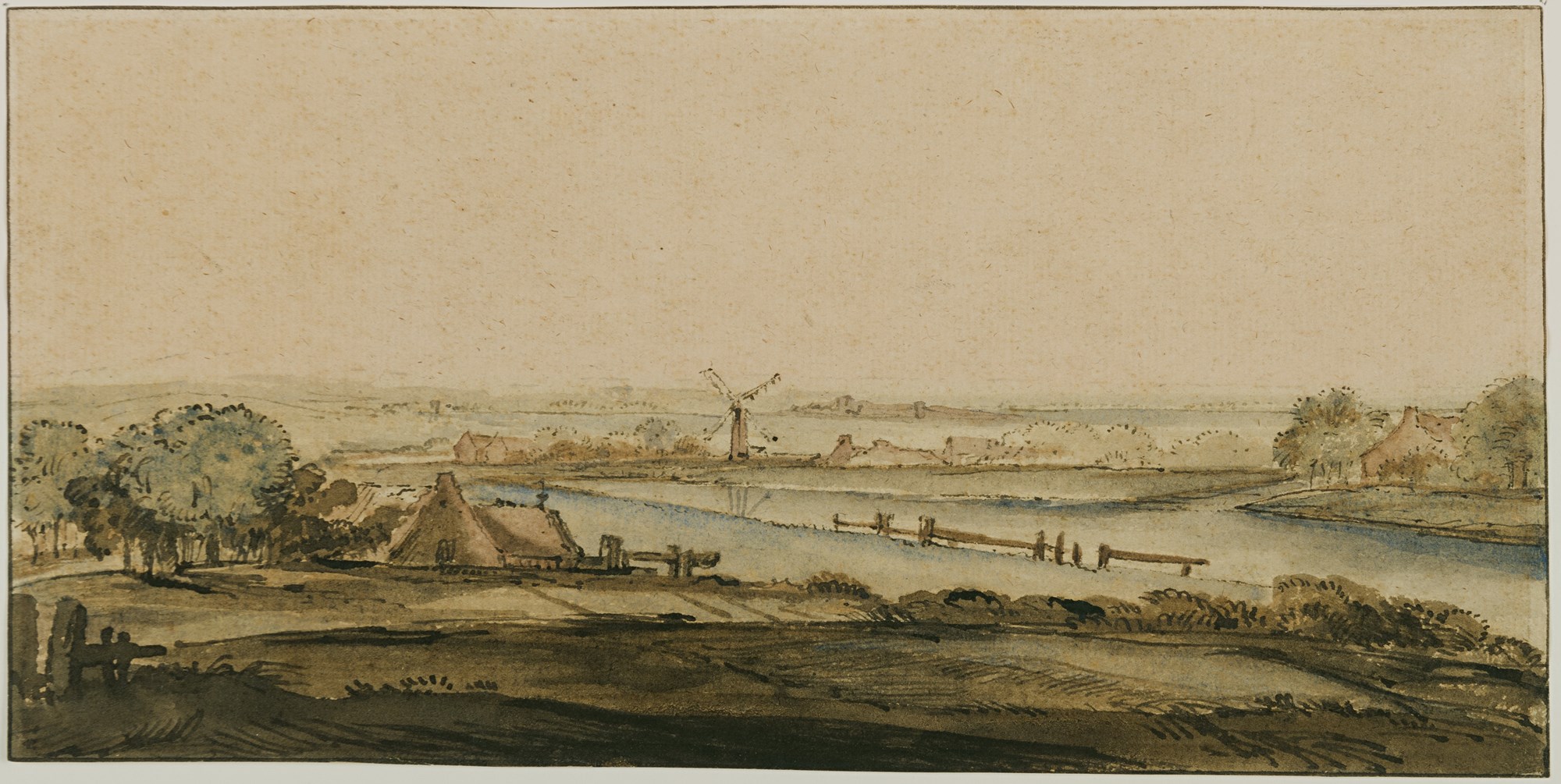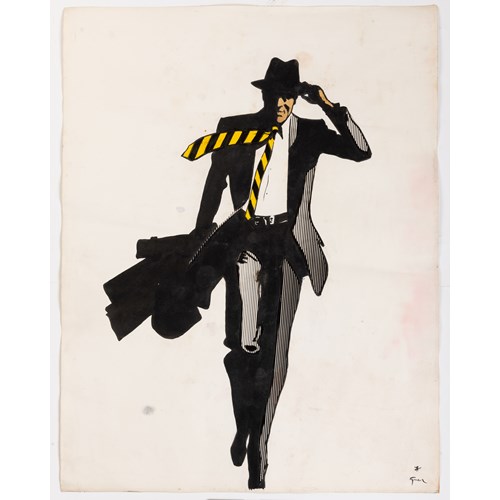Koninck is one of a handful of artists in Rembrandt’s circle who drew landscapes in watercolour, and his panoramic drawings are often similar to his painted views in their high vantage point and wide format. Peter Schatborn has suggested of such coloured landscape drawings that their ‘fine, controlled pen technique could be attributed to a desire on Koninck’s part to create a landscape that was more like a painting than a drawing, aiming for a kind of miniature painting in which pen and line…are subordinate to the colour’. Watercolour landscapes are uncommon in Dutch art of the 17th century, and works such as this must have been done as independent, finished works of art for sale to collectors, a practice that Koninck seems to have taken up late in his career, beginning in the 1660s.
The landscape composition of both the present sheet and its counterpart in the Pierpont Morgan Library is probably an imaginary one, rather than a topographically accurate view. As Kathleen Stuart and Jane Turner have written of the latter drawing, in terms equally applicable to the present sheet: ‘The [Morgan] sheet depicts a panoramic view of the Dutch lowlands executed in delicate watercolor washes. Koninck initially employed this medium in the 1640s and returned to it during the last decades of his life. In these late works, dark brown washes nearly obscure the underlying pen lines, resulting in views that are more pictorial than his earlier, more graphic subjects. With this drawing Koninck followed a compositional formula developed and perfected early in his career. Cut midway by the horizon line, the composition divides into halves, with the sky above and a broad, flat landscape below. The countryside, which is depicted from a slightly elevated viewpoint, is structured by contrasting areas of darks and lights as well as by an alternating pattern of horizontals and diagonals (usually a river or canal winding toward the distant horizon), often with one central structure, like the windmill here, piercing the horizon line. Although Koninck’s panoramas, both painted and drawn, are assumed to be imaginary, many are reminiscent of the rolling farm- and pastureland of Gelderland, one of the eastern provinces of the Netherlands. This view has not been identified and may be imaginary since the viewpoint is higher than is possible in the landscape it represents.’ Indeed, as Turner has pointed out elsewhere, ‘despite the convincing sense of light, air, space, and landscape detail of such vistas, they were often drawn from the artist’s imagination...Koninck could never had a vantage that allowed him to look simultaneously down upon and across such a flat landscape – even from atop the highest windmill.’
Sumowski pointed out that stylistically comparable landscape drawings by Philips Koninck of the 1670s are in the Kupferstichkabinett in Berlin, the Musée Condé in Chantilly, the Museum der Bildenden Künste in Leipzig and the British Museum in London. He further noted that Koninck is known to have occasionally produced two autograph versions of the same landscape composition, such as in a watercolour Panorama with a Landing and Sailboat Under a Low Sky, of which one variant is in the Teyler Museum in Haarlem and the other, showing much less of the sky, is in the Fondation Custodia in Paris.
Landscape watercolours by Koninck are very rare, and apart from the Morgan Library drawing, which was sold at auction in 1997, only two other examples, both datable to the 1670s, have appeared at auction in the past four decades. A River Landscape that was sold at auction in Paris in 1994 is now in the collection of the J. Paul Getty Museum in Los Angeles, while a panoramic landscape with the mouth of a river, datable to c.1670, was sold in 2004 and is now in a private collection. As Nicholas Turner has noted, ‘In his panoramic landscape paintings Koninck achieved spectacular effects of light and space. A feeling of openness, as well as a sense of weather in the ambient air, is also conveyed in the painter’s few colored drawings…which seem to have been made as finished works in their own right. They are among the rarest and most prized of seventeenth-century Dutch drawings.’
A native of Haarlem, A. M. (‘Ton’) van den Broek (1932-1995) began assembling an impressive collection of prints and books relating to the city of Haarlem in the 1960s. In later years he supplemented the collection with drawings and watercolours, including many landscape views of Haarlem and its environs.
Provenance: Anonymous sale, Amsterdam, Sotheby’s, 1 December 1986, lot 64
William Gwynn Fine Arts, Amsterdam
Anonymous sale, Amsterdam, Sotheby’s, 14 November 1988, lot 121 (bt. van den Broek)
A. M. ‘Ton’ van den Broek, Haarlem (his collector’s mark, not in Lugt, stamped in black ink on the verso).
Literature: Cara Dufour Denison et al, The Thaw Collection: Master Drawings and Oil Sketches. Acquisitions Since 1994, exhibition catalogue, New York, 2002-2003, p.16, under no.17 (entry by Jane Shoaf Turner); Rhoda Eitel-Porter et al, From Leonardo to Pollock: Master Drawings from the Morgan Library, exhibition catalogue, New York, 2006, p.100, under no.46 (entry by Kathleen Stuart and Jane Shoaf Turner); Jane Shoaf Turner, Dutch Drawings in The Pierpont Morgan Library: Seventeenth to Nineteenth Centuries, New York, 2006, Vol.I, p.93, under no.119; To be included in the forthcoming posthumous supplement (Vol.12) to Werner Sumowski, Drawings of the Rembrandt School.
More artworks from the Gallery









